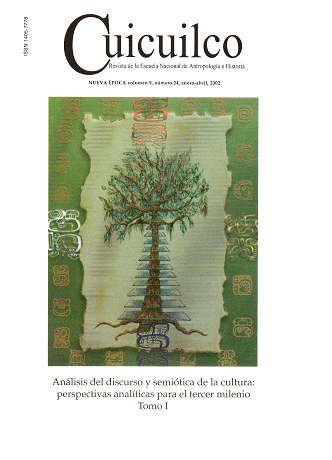Dossier
The function of the dynamic forces in the construction of meaning: cognitive interactions between academia and business in Mexico
Published 2014-07-29
Keywords
- function,
- dynamics,
- construction,
- meaning
How to Cite
The function of the dynamic forces in the construction of meaning: cognitive interactions between academia and business in Mexico. (2014). Cuicuilco Revista De Ciencias Antropológicas, 9(24), 61-78. https://revistas.inah.gob.mx/index.php/cuicuilco/article/view/328
Abstract
This research examines a corpus about the generation and transmission of knowledge between universities and industry in Mexico. This article analyzes the interplay of three parameters of force dynamics [Talmy, 1988:54] in two different construals of the same reality. At the discourse level, force dynamics are displayed through the construction of mental spaces [Fauconnier, 1985, 1997].Downloads
Download data is not yet available.
References
- Castaños, Fernando. 1996a Discourse in EOL Research and Design: the Basic Units, PhD. Thesis, Londres, Institute of Education, University of London.
- Castaños, Fernando. 1996b “Comunicación: sujetos, lenguaje”, en Los mexicanos de los noventa, México, UNAM - IIS, pp. 123-141.
- Castaños, Fernando. 1997. “Observar y entender la cultura política: algunos problemas fundamentales y una propuesta de solución”, en Revista Mexicana de Sociología, México, núm. 59, UNAM-IIS, pp. 75-91.
- Durkheim, Emile. 1912. The Elementary Forms of Religious Life, Nueva York, Free Press.
- Fauconnier, Gilles. 1985. Mental Spaces, Cambridge, MIT.
- Fauconnier, Gilles. 1997. Mappings in Thought and Language, Cambridge, CUP.
- Geertz, Clifford. 1973. The Interpretation of Cultures, Nueva York, Basic Books.
- Halliday, Michael. 1994. An Introduction to Functional Grammar, Londres, Edward Arnold.
- Jackendoff, Ray. 1990. Semantic Structures, Cambridge, MIT.
- Lara, Luis Fernando. 1990. Dimensiones de la lexicografía, México, COLMEX.
- Lara, Luis Fernando (ed.). 1996. Diccionario del español usual en México, México, COLMEX.
- Lyons, John. 1977. Semantics, Cambridge, CUP.
- Riley, P. 1996. “Look in the heart and write”, en Ventola, E y Maranen, A (eds.), Academic Writing, Amsterdam, John Benjamin.
- Sweetser, Eve. 1990. From etymology to pragmatics, Cambridge, CUP.
- Talmy, Leonard. 1988. “Force dynamics in language and cognition”, en Cognitive Science, n.m. 12, pp. 49-100.
- Talmy, Leonard. 2000 Toward a Cognitive Semantics, Cambridge, MIT.
- Traugott, Elizabeth. 1982. “From prepositional to textual and expresive meaning: some semanticpragmatic aspects of grammaticalization”, en Lehmann, W. y Malkiel, Y. (eds), Perspectives on historical linguistics I, Amsterdam, Benjamin, pp. 245-271.
- Thompson, J. B. 1988. Ideology and Modern Culture, Cambridge.
- Van Dyke, Teun. 2001. “Algunos principios de la teoría del contexto”, en Revista latinoamericana de estudios del discurso, núm. 1, pp. 69-81.
- Vázquez, Ma. Eugenia. 1999. Modalidad deóntica y acción comunicativa, Tesis doctoral, COLMEX.
- Vázquez, Ma. Eugenia. 1999. “Modalidad deóntica objetiva y subjetiva”, en Nueva Revista de Filología Hispánica, núm. 1, pp. 1-32.

